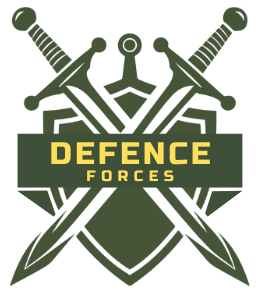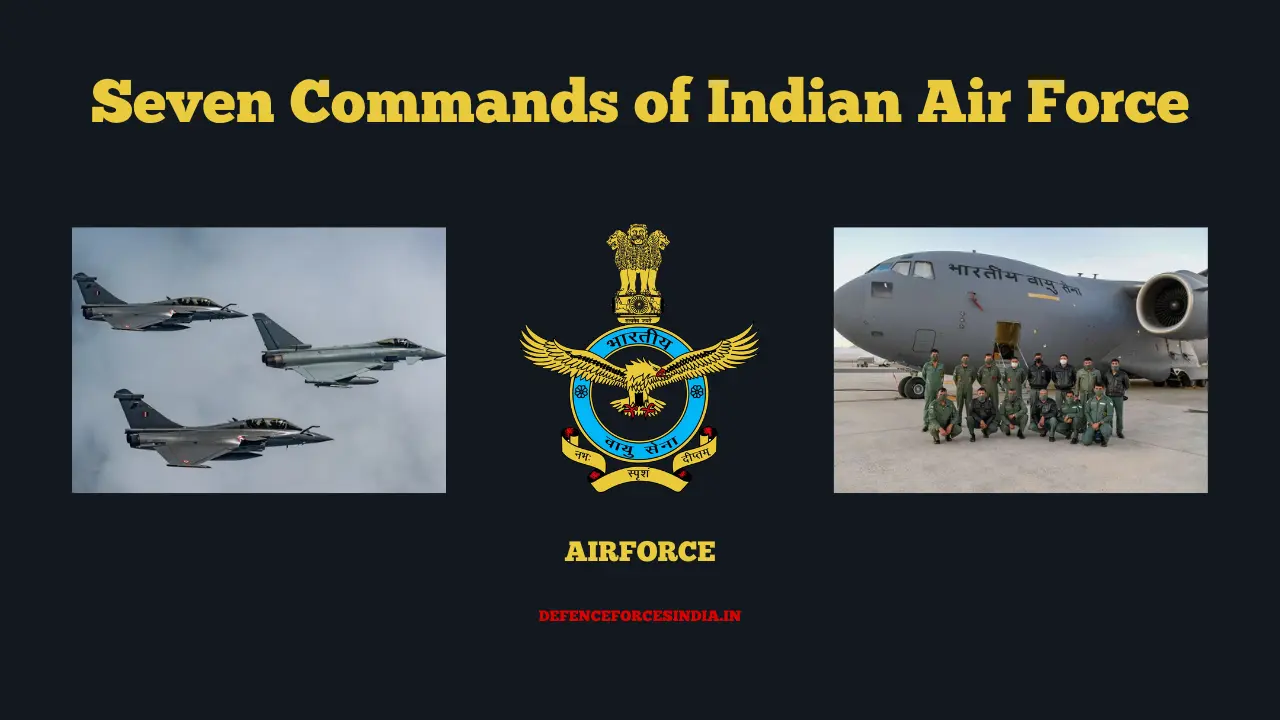Commands of Indian Air Force:The Indian Air Force (IAF), one of the most formidable air forces globally, operates through a robust organizational structure, including seven distinct commands. These commands are strategically positioned to ensure optimal defense capabilities and operational efficiency.
Introduction to the Indian Air Force (IAF)
The Indian Air Force is a cornerstone of India’s defense system, tasked with protecting the nation’s airspace and conducting aerial warfare during conflicts. Established on October 8, 1932, the IAF has evolved into a highly advanced force, thanks to technological advancements and dedicated personnel.
Historical Background
Initially formed as an auxiliary air force under British rule, the IAF played a pivotal role in World War II. Post-independence, it expanded rapidly, embracing modern aircraft and strategies to become a critical part of India’s military triad.
Structure of the Indian Air Force
Hierarchy and Organization
The IAF operates under the Ministry of Defence, led by the Chief of the Air Staff. Its structure comprises operational commands, training institutions, and support wings.
Key Divisions and Responsibilities
- Combat Commands: Handle operational missions and national security threats.
- Support Commands: Manage maintenance, logistics, and training.
Table of Contents
What Are the Commands in the Indian Air Force?
Commands in Indian Air Force are large, strategic units tasked with managing specific geographical or operational areas. They ensure that the IAF operates efficiently and remains prepared for any threats. Each command has a specific focus, whether it’s combat operations, training, maintenance, or support. Together, these commands form the backbone of the Indian Air Force, ensuring seamless coordination and execution of defense strategies.
The Seven Commands of the Indian Air Force
1. Western Air Command (WAC)
The Western Air Command, headquartered in New Delhi, is the largest and most significant command in the IAF. It oversees operations in the north and western regions of India, including areas along the Pakistan border.
Key Responsibilities:
- Maintaining air superiority along the western front.
- Providing support to the Army in operations along the Line of Control (LoC).
- Managing critical airbases such as Ambala, Srinagar, and Chandigarh.
Historical Significance:
WAC has been instrumental in several conflicts, including the 1965 and 1971 wars with Pakistan. Its role in safeguarding the northern and western borders is unparalleled.
2. Eastern Air Command (EAC)
The Eastern Air Command operates from Shillong, Meghalaya, and manages operations in the northeastern region of India.
Key Responsibilities (Eastern Air Command – EAC):
- Ensuring aerial security along the Indo-China border.
- Supporting ground forces in counter-insurgency operations.
- Protecting strategic locations such as the Northeast’s sensitive terrain and airspace.
Historical Significance:
EAC played a pivotal role during the 1962 Sino-Indian War and continues to act as a deterrent against threats from the northeastern frontiers. It also conducts humanitarian aid missions, especially during natural disasters like floods and landslides.
Key Responsibilities (Eastern Air Command – EAC):
- Ensuring aerial security along the Indo-China border.
- Supporting ground forces in counter-insurgency operations.
- Protecting strategic locations such as the Northeast’s sensitive terrain and airspace.
Historical Significance:
EAC played a pivotal role during the 1962 Sino-Indian War and continues to act as a deterrent against threats from the northeastern frontiers. It also conducts humanitarian aid missions, especially during natural disasters like floods and landslides.
3. Central Air Command (CAC)
The Central Air Command, headquartered in Prayagraj (Allahabad), Uttar Pradesh, focuses on the country’s heartland.
Key Responsibilities:
- Managing logistics and support for central India.
- Acting as a reserve force for northern and eastern commands.
- Maintaining air defense systems in its jurisdiction.
Historical Significance:
CAC has been vital in disaster relief missions and non-combat operations like food supply drops and medical evacuations. Its strategic positioning allows it to respond quickly to national emergencies.
4. Southern Air Command (SAC)
The Southern Air Command is headquartered in Thiruvananthapuram, Kerala, and oversees operations in southern India, including the coastal regions and islands.
Key Responsibilities:
- Protecting India’s maritime airspace, particularly over the Indian Ocean.
- Supporting naval operations and surveillance missions.
- Conducting operations in India’s island territories like the Andaman and Nicobar Islands.
Historical Significance:
SAC has been crucial in anti-piracy missions, monitoring international shipping lanes, and disaster relief operations, including post-tsunami rescue efforts.
5. South Western Air Command (SWAC)
Based in Gandhinagar, Gujarat, the South Western Air Command manages operations in the southwestern region, including Rajasthan and Gujarat.
Key Responsibilities:
- Ensuring air defense along the India-Pakistan border in the west.
- Supporting Army and Navy operations in the region.
- Conducting surveillance over critical desert terrains.
Historical Significance:
SWAC played a vital role during the Kargil War and continues to monitor India’s western border, ensuring the safety of key strategic installations.
6. Training Command (TC)
Headquartered in Bengaluru, Karnataka, the Training Command is responsible for shaping the future of the IAF.
Key Responsibilities:
- Providing basic and advanced training to IAF personnel.
- Operating training establishments such as the Air Force Academy and Air Force Technical College.
- Developing new training methodologies and technologies.
Historical Significance:
Training Command ensures the IAF remains one of the best-trained air forces globally. It has consistently produced world-class pilots and ground personnel through rigorous and innovative training programs.
7. Maintenance Command (MC)
Located in Nagpur, Maharashtra, the Maintenance Command handles the upkeep of IAF’s assets, including aircraft, radar systems, and communication networks.
Key Responsibilities:
- Repairing and overhauling aircraft, engines, and other critical equipment.
- Managing supply chains and logistics for spare parts and weaponry.
- Ensuring operational readiness through preventive maintenance.
Historical Significance:
Maintenance Command plays an unsung yet vital role in ensuring the IAF’s fleet remains battle-ready at all times. Its efforts significantly enhance the longevity and reliability of the IAF’s resources.
Strategic Importance of Each Command
Each command plays a distinct role in maintaining India’s air superiority. Together, they ensure:
- Quick and effective responses to threats across multiple fronts.
- Enhanced operational readiness for combat and non-combat missions.
- Efficient utilization of resources, from personnel to technology.
Innovations and Modernizations in the Commands
To stay ahead, the IAF has embraced cutting-edge technology:
- Western and Eastern Commands: Deployment of advanced fighter jets like the Rafale and Sukhoi Su-30 MKI.
- Training Command: Integration of simulators and AI in pilot training.
- Maintenance Command: Adoption of predictive maintenance and data analytics for fleet management.
Challenges Faced by the Commands
Despite their strengths, the commands encounter challenges, such as:
- Geographic Difficulties: Harsh terrains like deserts, mountains, and dense forests.
- Technological Gaps: Rapidly evolving global defense technologies.
- Resource Allocation: Balancing combat readiness with financial constraints.
Efforts are ongoing to address these issues, including infrastructure upgrades and international collaborations.
Comparing Indian Air Force Commands with Other Air Forces
The structure of the IAF commands is comparable to that of other leading air forces, such as:
- United States Air Force (USAF): Focuses on global reach with commands like Air Combat Command and Pacific Air Forces.
- Royal Air Force (RAF): Balances combat and non-combat operations through flexible command structures.
India’s unique geography necessitates specialized roles for each command, making its structure both distinct and effective.
Frequently Asked Questions (FAQs)
Q1: Where are the 7 commands of Indian Air Force located?
A: The commands are based in New Delhi, Shillong, Prayagraj, Thiruvananthapuram, Gandhinagar, Bengaluru, and Nagpur.
Q2: Which is the largest command in the IAF?
A: The Western Air Command is the largest and most operationally significant.
Q3: What is the role of the Training Command?
A: It provides training to IAF personnel, shaping future pilots and technical experts.
Q4: How does the Maintenance Command support the IAF?
A: It handles the repair, overhaul, and logistics of IAF equipment to ensure operational readiness.
Q5: Why is the Eastern Air Command important?
A: It protects India’s northeastern borders and supports counter-insurgency operations.
Q6: How does the Southern Air Command assist in maritime security?
A: It oversees surveillance and operations in the Indian Ocean and island territories.
Conclusion and the Future of the IAF Commands
The seven commands of the Indian Air Force are pillars of strength, ensuring the country’s security across land, sea, and air. As technology advances, these commands are poised to evolve further, enhancing India’s defense capabilities and maintaining its status as a global power.
Recent Posts
- Indian Air Force Recruitment 2025: Apply Now for Agniveervayu (Sports) Intake 02/2025 17 February 2025
- CISF Recruitment 2025: Apply for 1124 Constable/Driver & Other Posts – Check Eligibility, Salary & Selection Process 11 February 2025
- Indian Navy Recruitment 2025: Apply Online for 270 Vacancies – Check Eligibility, Salary & Selection Process 11 February 2025
- Indian Army Recruitment 2025: Apply Now for 381 Vacancies Before 05 February 19 January 2025
- Ministry of Textiles Recruitment 2025: Apply for Junior Weaver, Junior Assistant, and Other Posts 19 January 2025
Categories
- Bank Jobs (4)
- Central & State Govt Jobs (54)
- Defence Guide (36)
- Defence Jobs (30)
- Home (2)
- Private & IT Jobs (8)
- Results (2)

